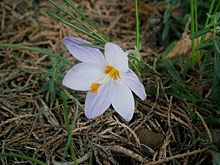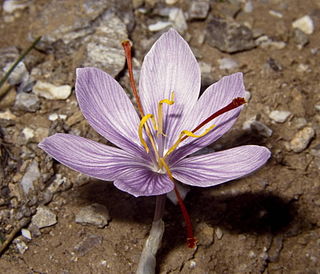
Crocus cartwrightianus is a species of flowering plant in the family Iridaceae, native to mainland Greece and Crete. It is a cormous perennial growing to 5 cm (2 in). The flowers, in shades of lilac or white with purple veins and prominent red stigmas, appear with the leaves in autumn and winter.
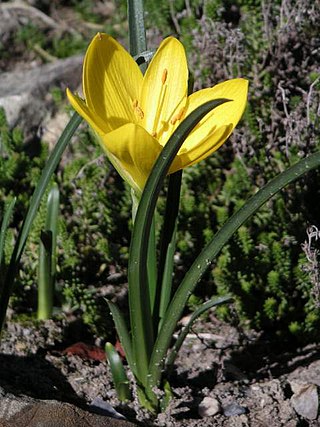
Sternbergia lutea, the winter daffodil, autumn daffodil, fall daffodil, lily-of-the-field, or yellow autumn crocus, is a bulbous flowering plant in the family Amaryllidaceae, subfamily Amaryllidoideae, in the Narcisseae tribe, which is used as an ornamental plant. It has yellow flowers which appear in autumn.

Crocus banaticus, syn. C. iridiflorus, is a species of flowering plant belonging to the family Iridaceae, native to the Balkans, particularly in Serbia, Romania and south western Ukraine. It creates its own subgenus in the Crocus subfamily known as Crociris. It is a cormous perennial growing to 10 cm (4 in).

Geranium psilostemon, commonly called Armenian cranesbill, is a species of hardy flowering herbaceous perennial plant in the genus Geranium, family Geraniaceae. It is native to Turkey, Armenia, Azerbaijan, and the Russian Federation. Forming a large clump to 120 cm (47 in) tall, it has glowing reddish purple colored flowers with prominent dark centres, and divided leaves tinted red in Autumn. It is cultivated as a garden subject, and a number of different cultivars exist. G. psilostemon has the UK’s hardiest rating, surviving temperatures as low as −20 °C (−4 °F).

Crocus chrysanthus, the snow crocus or golden crocus, is a species of flowering plant of the Crocus genus in the family Iridaceae. Native to the Balkans and Turkey, it bears vivid orange-yellow bowl-shaped flowers. It has smaller corms and a smaller flower than the giant Dutch crocus, although it produces more flowers per corm than the latter. Its common name, "snow crocus", derives from its exceptionally early flowering period, blooming about two weeks before the giant crocus, and often emerging through the snow in late winter or early spring. The leaves are narrow with a silver central stripe. Height: 3–4 inches (7.6–10.2 cm).
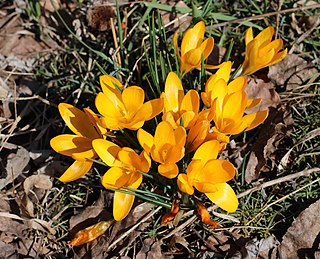
Crocus flavus, known as yellow crocus, Dutch yellow crocus or snow crocus, is a species of flowering plant in the genus Crocus of the family Iridaceae. It grows wild on the slopes of Greece, former Yugoslavia, Bulgaria, Romania and northwestern Turkey, with fragrant bright orange-yellow flowers. It is a small crocus (5–6 cm, despite the names of some cultivars, compared to the giant Dutch crocuses. Its cultivars are used as ornamental plants.
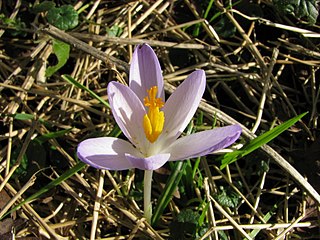
Crocus tommasinianus, the woodland crocus, early crocus, or Tommasini's crocus, is a flower named after the botanist Muzio G. Spirito de Tommasini (1794-1879). It is native to Bulgaria, Hungary, Albania, and the former Yugoslavia. It is often referred to as the early or snow crocus, but these terms are shared with several other species, although C. tommasinianus is amongst the first to bloom. Multiple plants are often called tommies in the horticultural trade.

Colchicum speciosum is a species of flowering plant in the family Colchicaceae, native to mountainous areas of northern Turkey, the Caucasus and northern Iran. Growing to 18 cm (7 in) tall by 10 cm (4 in) wide, it is an herbaceous perennial growing from corms. C. speciosum blooms in the fall, producing reddish/violet flowers on stems up to 30 centimetres (12 in) tall without any leaves present. The strap-like leaves grow in the spring, then yellow, wither and die back as summer progresses. The flowers strongly resemble those of the crocus, the familiar spring-flowering bulb; hence the common name autumn crocus which is applied to this and other colchicum species. However the two genera belong to different families; and there is in fact an autumn-flowering crocus species, Crocus sativus, the source of the spice saffron. By contrast, all parts of Colchicum speciosum are toxic if ingested.

Colchicum × agrippinum is a species of flowering plant in the family Colchicaceae. It is considered to be a hybrid between C. variegatum and C. autumnale, and not a true species, although this is not certain. The genus and the species are commonly called autumn crocus, naked lady or meadow saffron.

Colchicum cilicicum, the Tenore autumn crocus, is a species of flowering plant in the Colchicaceae family. A bulbous perennial, it bears deep rose-lilac flowers in late summer, with barely any chequered pattern on the petals (tessellation). It has a very noticeable white stripe down the centre of each petal, which gives it a star-like appearance at the base. The flowers tend to stand up to weather better than other colchicum blooms. The flowers appear before the strap-like leaves, giving this and other colchicum species the common name “naked lady”. Although colchicums are called “autumn crocuses” they belong to a different family than true crocuses. There are in fact autumn-flowering species of crocus such as Crocus sativus, which is the source of the spice saffron. Colchicum cilicicum, by contrast, is toxic if eaten.

Tecophilaea cyanocrocus, the Chilean blue crocus, is a flowering perennial plant that is native to Chile, growing at 2,000 to 3,000 m elevation on dry, stony slopes in the Andes mountains. Although it had survived in cultivation due to its use as a greenhouse and landscape plant, it was believed to be extinct in the wild due to overcollecting, overgrazing, and general destruction of habitat, until it was rediscovered in 2001.

Crocus ligusticus is a herbaceous perennial plant belonging to the genus Crocus of the family Iridaceae. The genus nane Crocus is a Chaldean name meaning "saffron", while the specific Latin name ligusticus, meaning ligurian, refers to the distribution area of this species.

Heliopsis helianthoides is a species of flowering plant in the family Asteraceae, known by the common names rough oxeye, smooth oxeye and false sunflower. It is native to eastern and central North America from Saskatchewan east to Newfoundland and south as far as Texas, New Mexico, and Georgia.

Crocus goulimyi, the fall crocus, is a species of flowering plant in the genus Crocus and the family Iridaceae. It is endemic to Greece. It is a cormous perennial growing to 10 cm (3.9 in) tall. The small, rounded, lilac flowers with paler throats appear in autumn.

Crocus speciosus, with common name Bieberstein's crocus, is a species of flowering plant in the genus Crocus of the family Iridaceae. The plant is native to northern and central Turkey, the Caucasus, northern Iran, Crimea and Bulgaria.
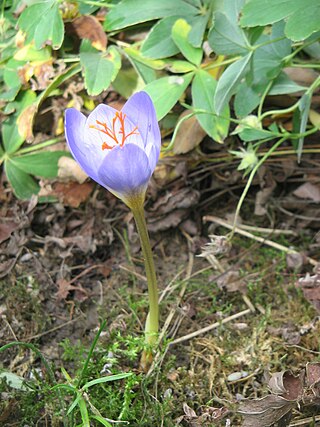
Crocus pulchellus, the hairy crocus, is a species of flowering plant in the genus Crocus of the family Iridaceae, found the Northern Balkan Peninsula to Northwestern Turkey.

Crocus kotschyanus, Kotschy's crocus, is a species of flowering plant in the genus Crocus of the family Iridaceae, found from Turkey to Caucasus and Lebanon.

Crocus longiflorus, the long-flowered crocus, is a species of flowering plant in the genus Crocus of the family Iridaceae, found in Southwest Italy, Sicilia, and Malta.

Crocus malyi, the Maly crocus, is a species of flowering plant in the genus Crocus of the family Iridaceae, endemic to Croatia.
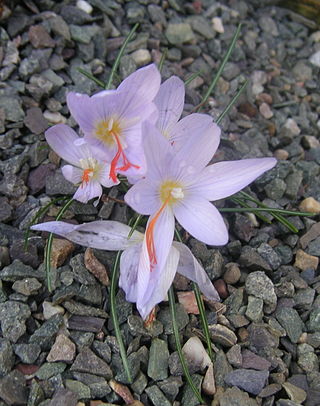
Crocus tournefortii, the Tournefort crocus, is a species of flowering plant in the iris family Iridaceae, from South Greece and Northern Crete.
